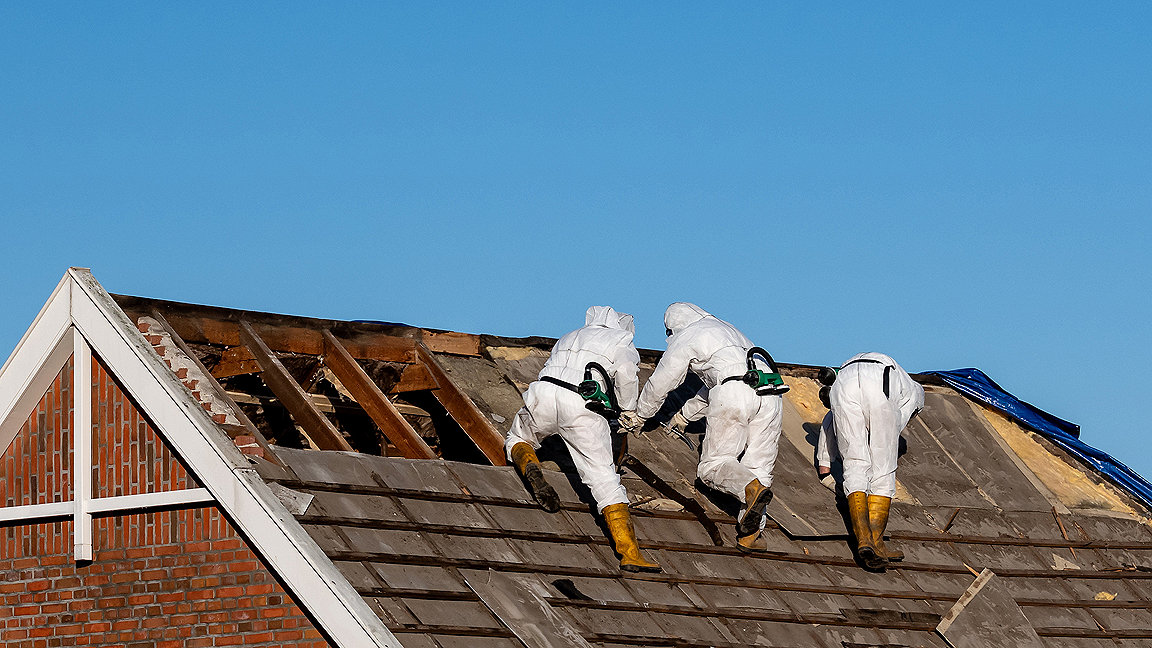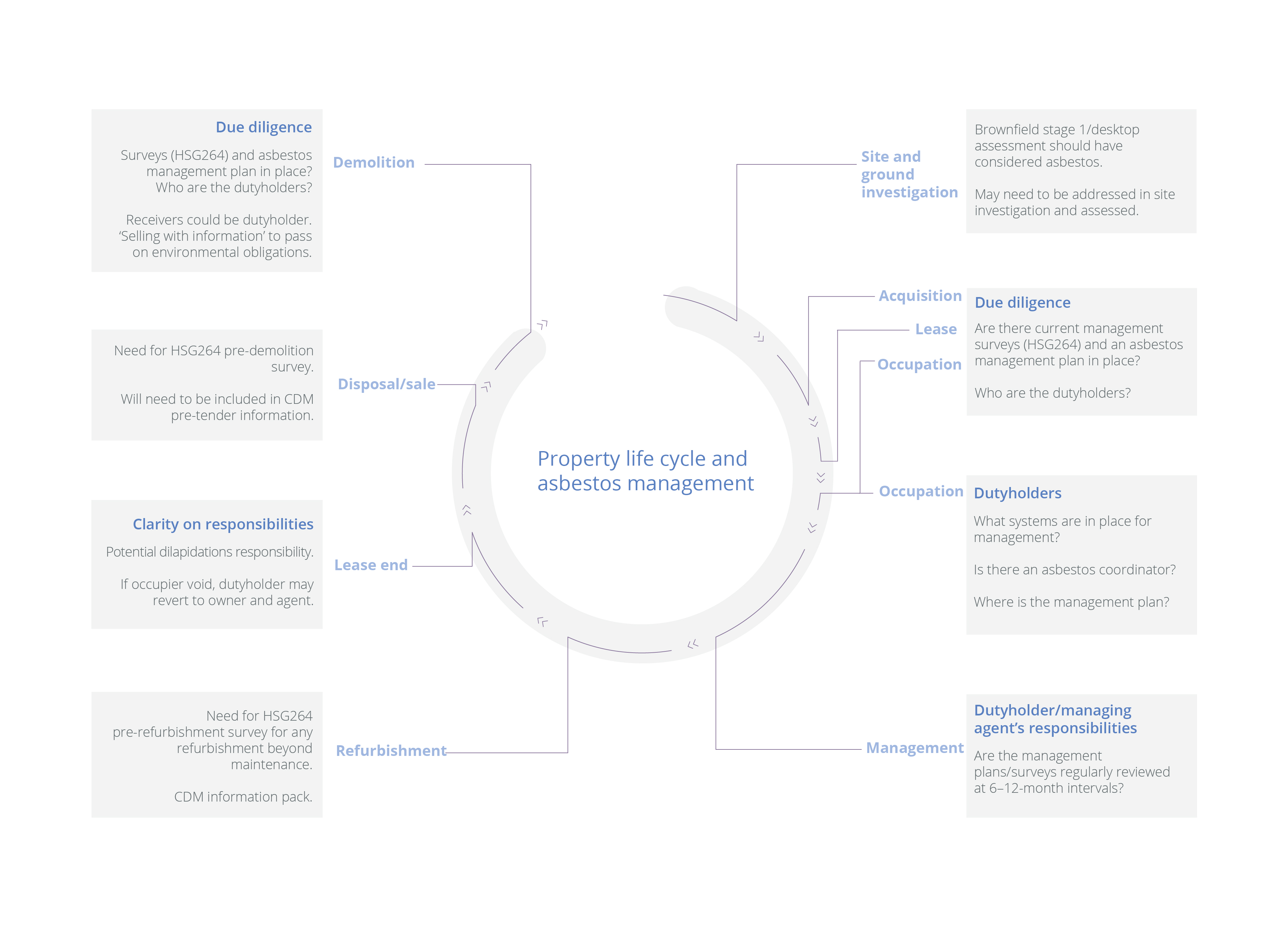
Asbestos removal on a roof
Asbestos remains a deadly risk in some older buildings, so every surveyor needs to know how to identify its presence. An awareness of asbestos is also particularly relevant to the mandatory competency Health and safety, as well as to technical competencies such as Inspection and Legal/regulatory compliance.
At Level 1 for all these competencies, candidates need to understand what asbestos is and why it is regulated. At Levels 2 and 3, they may be able to provide examples of having dealt with asbestos-related issues or advised a client on the implications of its presence.
This article will take candidates through some of the key issues to consider in relation to the substance, including the new Asbestos: legal requirements and best practice for property professionals and clients RICS guidance note.
Be aware that, in this article, the term 'ACM' is used to denote asbestos-containing material, but in other contexts it can be used to denote aluminium-composite material in cladding. Candidates should therefore note the differences in their use, and if in doubt state the full name rather than the abbreviation.
The key issues
All surveyors need to be aware of the risks relating to asbestos, so they can advise clients diligently and protect the health and safety of themselves and others. Asbestos is harmful to health, and the World Health Organization classifies it as a group 1 carcinogen, which means that there is significant evidence of it causing cancer in humans.
If asbestos is disturbed, it releases fibres into the atmosphere that, if inhaled can lead to asbestosis, one of the complications of which can be the cancer mesothelioma. There is often a lag between exposure and health issues, which can be between 20 and 50 years, and around 20 tradespeople die each week in the UK from previous exposure to asbestos. As symptoms tend only to be noticed years after exposure – sadly, once it is too late – this makes asbestos-related diseases extremely challenging to treat.
Where to look for asbestos
- acoustic plaster
- adhesives
- ceiling tiles
- cement pipes and wallboard
- decorative plaster
- ducting
- fire curtains and doors
- fireproofing
- pipe insulation
- roof felt
- textured paint and coatings
- vinyl floor tiles
- wallboard.
Surveyors may encounter asbestos-related issues at various stages in the property life cycle, as shown in Figure 1.

If a building was constructed before 2000, then surveyors should always assume that asbestos may be present. The key thing to remember is to seek specialist advice when conducting inspections on all such buildings, as most surveyors will not be qualified to advise clients about asbestos.
However, at Level 3 candidates can advise clients on the implications of its presence, for instance in valuation instructions or refurbishment/demolition surveys.
'If a building was constructed before 2000, then surveyors should always assume that asbestos may be present'
Guidance and legislation
All surveyors should familiarise themselves with the legal requirements detailed in the new RICS asbestos guidance note. While it relates specifically to UK legislation, it is of wider international application given that it also represents best practice.
The guidance note replaces the third edition of Asbestos and its implications for surveyors and their clients, which was published before the Control of Asbestos Regulations 2012 came into force. The new document aims not only to ensure that surveyors and their clients comply with the relevant UK legislation, but also reduce their risk of exposure to asbestos.
Surveyors also need to be aware of the following legislation, regulations and guidance:
The Health and Safety at Work etc. Act 1974, which places a duty of care on them to manage and control asbestos-related risk.
The Control of Asbestos Regulations 2012, which detail specific duties relating to the management of the substance.
The Construction (Design and Management) Regulations (CDM) 2015, which relate to health and safety in construction.
Approved Code of Practice (ACOP) L143, Managing and working with asbestos, second edition, published by the Health and Safety Executive (HSE).
HSG264, Asbestos: The Survey Guide, second edition, also published by HSE.
Other government guidance, such as CL:AIRE guidance on asbestos in soil (CAR-SOIL).
All surveyors should have received asbestos awareness training in line with the Control of Asbestos Regulation 10 as well, including how to identify asbestos when inspecting premises.
Duties relating to asbestos
A duty to manage asbestos arises under Control of Asbestos Regulation 4 and applies to all non-domestic premises, including public buildings and the common parts of houses in multiple occupation.
Where the duty to manage under regulation 4 does not apply, a duty arises under sections 2 and 3 of the 1974 Act for anyone conducting business, e.g. landlords, to minimise the risk from asbestos to the health and safety of others in domestic premises. The Defective Premises Act 1972 and the Homes (Fitness for Human Habitation) Act 2018 also emphasise this duty in domestic premises. The duty can be fulfilled by ensuring that an asbestos register is available, assessing the risk of any asbestos present and making this information available to anyone liable to disturb it.
Appendix B of the guidance note sets out how to identify the dutyholder, and how the duty to manage applies to a variety of asset types. Where an organisation owns premises, for instance, it will be the dutyholder and have an obligation to manage asbestos and ensure the safety of its staff.
Where a managing agent is instructed, the landlord as the dutyholder cannot delegate the statutory duty to manage asbestos. However, the landlord can claim – contractually, or in tort for a non-contractual duty – against the agent if any action or inaction contributes to the former's failure to comply as a dutyholder. The agent will also have a duty to manage asbestos risk under the 1974 Act. If the landlord is absent the dutyholder may acquire additional responsibilities, because they may be considered to be in charge of the property.
If a surveyor is instructed to carry out refurbishment or building works, they may have a contractual duty and direct responsibility under regulation 5 to collate information on asbestos risk in the form of refurbishment/demolition survey before works commence. This could include ensuring the client provides this as part of the pre-construction information required under CDM 2015.
There are many other instances where surveyors may acquire or have a duty of care in relation to asbestos risk management, so they should ensure they read the guidance note in full.
- take reasonable steps to find materials likely to contain asbestos
- presume materials contain asbestos unless there is strong evidence to suppose they do not
- assess the risk of anyone being exposed to asbestos from these materials
- make a written record in the management survey of the location and condition of ACMs and presumed ACMs and keep it up to date
- repair or remove any material that contains or is presumed to contain asbestos, if necessary, because of its location, condition or the likelihood of it being disturbed
- prepare and put into effect an asbestos management plan (AMP) to manage exposure risk.
The asbestos register should be updated annually, or more frequently if the risk of deterioration is high. It should also be provided to contractors or surveyors when inspections or work are being carried out.
The management plan should be reviewed every six months or after refurbishment, change of use, or revisions to company procedures.
Breaches and removal
In the event of a substantial breach of the 2012 Regulations, the penalties include an unlimited fine and up to two years' imprisonment.
If asbestos needs to be removed, then contractors must comply with the 2012 Regulations. Higher-risk work is generally required to be undertaken by a licensed contractor (licensable work), e.g., removing sprayed coatings or work involving loose fill insulation.
For the removal of licensable asbestos, workers need to be on the licence list. Non-licensable asbestos means, as would be expected, that contractors do not generally need to be licensed, but they must be suitably trained all the same. However, in some cases even non-licensed work must be notified to HSE, written records kept and contractors placed under health surveillance by their GP.
In any case, all ACMs must be disposed of at a site licensed by the Environment Agency.
Awareness remains essential
- If a valuation surveyor suspects that asbestos is present, then they must recommend to their client that specialist advice is sought. They can then reflect the impact of the asbestos in their valuation advice.
- Before any purchase or sale, a surveyor will need to review a copy of the asbestos report for the property. This will often be requested by the lawyers as part of the due diligence process, and is essential to providing prudent client advice.
- For a leasing or letting, a surveyor will want to see an asbestos report to ensure that they can manage the associated risk for your client.
- Property managers are required to carry out diligent asbestos management and understand who the dutyholder is.
A lack of understanding is likely to lead to a referral during the APC – particularly because providing a high standard of service and promoting trust in the profession are two of the five professional and ethical standards.
Jen Lemen FRICS is a partner at Property Elite, providing training and support to APC and AssocRICS candidates
Contact Jen: Email
Related competencies include: Health and safety, Inspection
